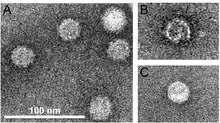Betanodavirus
Betanodavirus, or nervous necrosis virus (NNV), is a genus of nonenveloped positive-strand RNA viruses in the family Nodaviridae.[1] Member viruses infect fish and cause viral nervous necrosis (VNN) and viral encephalopathy and retinopathy (VER).[2] The genus contains four species.[3]
| Betanodavirus | |
|---|---|
 | |
| Electron micrographs of grouper nervous necrosis virus particles | |
| Virus classification | |
| (unranked): | Virus |
| Realm: | Riboviria |
| Kingdom: | Orthornavirae |
| Phylum: | Kitrinoviricota |
| Class: | Magsaviricetes |
| Order: | Nodamuvirales |
| Family: | Nodaviridae |
| Genus: | Betanodavirus |
History
Betanodaviruses were first reported between 1989–1991. They were linked with high mortality rates in young fish and were initially described as a picornavirus-like virus. They were discovered around the same time in Australia, Norway, France and Japan.[4][5][6][7] The oldest evidence related to the virus, however, dates back to 1984 in Queensland (Australia) where a disease outbreak with the clinical signs and histopathological lesions corresponding to NNV was reported.[8]
Virology
Structure

Viruses in the genus Betanodavirus are non-enveloped, with icosahedral geometries and T=3 symmetry.[2] The diameter is around 37 nm. The virus-like particle contains 180 subunits of the capsid protein, and each capsid protein (CP) shows three major domains: (i) the N-terminal arm, an inter-subunit extension at the inner surface; (ii) the shell domain (S-domain), a jelly-roll structure; and (iii) the protrusion domain (P-domain) formed by three-fold trimeric protrusions.[9]
Genomes
Genomes are linear, segmented, bipartite, and around 21.4kb in total length.[2] The genome is split in two segments RNA1 and RNA2 that together encode three genes.[4]
Life cycle
Viral replication is cytoplasmic. Entry into the host cell is achieved by penetration into the host cell. Replication follows the positive stranded RNA virus replication model. Positive stranded RNA virus transcription, using the internal initiation model of subgenomic RNA transcription is the method of transcription. Fish serve as the natural host. Transmission routes are passive diffusion and contact.[2]
Disease
Betanodaviruses affect teleost fish. A number of species are reported susceptible, more than 40 species, most of them marine. Transmission routes are passive diffusion and contact.[2] The disease is more likely to occur in larvae or juveniles but it can also affect adults.[10]
Clinical signs and lesions

Viral nervous necrosis can have a clinical or sub-clinical presentation. Signs include: abnormal behaviour like lethargy, anorexia, spiral swimming; and change in pigmentation. Mortalities of affected populations can be of up to 100%.[11] Microscopical lesions are mostly located in brain, retina and spinal cord where necrosis of the neurons and the presence of round empty spaces called vacoules are commonly associated with the disease.
Evolution
The most recent common ancestor of the four extant genotypes has been dated to ~1300 CE.[12] An early reassortment event appears to have occurred in the early 1980s in Southern Europe.
Taxonomy
The following species are recognized:[13]
- Barfin flounder nervous necrosis virus
- Redspotted grouper nervous necrosis virus
- Striped jack nervous necrosis virus
- Tiger puffer nervous necrosis virus
References
- Sahul Hameed, AS; Ninawe, AS; Nakai, T; Chi, SC; Johnson, KL; ICTV Report, Consortium (January 2019). "ICTV Virus Taxonomy Profile: Nodaviridae". The Journal of General Virology. 100 (1): 3–4. doi:10.1099/jgv.0.001170. PMID 30431412.
- "Viral Zone". ExPASy. Retrieved 12 June 2015.
- Cann, Alan (2001). Principles of Molecular Virology. Academic Press. pp. 870–871. ISBN 9780121585334. Retrieved 7 September 2020.
- Mori, Koh-Ichiro; Nakai, Toshihiro; Muroga, Kiyokuni; Arimoto, Misao; Mushiake, Keiichi; Furusawa, Iwao (1992). "Properties of a new virus belonging to nodaviridae found in larval striped jack (Pseudocaranx dentex) with nervous necrosis". Virology. 187 (1): 368–71. doi:10.1016/0042-6822(92)90329-N. PMID 1736540.
- Glazebrook, J. S; Heasman, M. P; Beer, S. W (1990). "Picorna-like viral particles associated with mass mortalities in larval barramundi, Lates calcarifer Bloch". Journal of Fish Diseases. 13 (3): 245–9. doi:10.1111/j.1365-2761.1990.tb00780.x.
- Bloch, B., Gravningen, K. & Larsen, J. L. (1991). Encephalomyelitis among turbot associated with picornavirus-like agent. Diseases of Aquatic Organisms 10.
- Breuil, G; Bonami, J.R; Pepin, J.F; Pichot, Y (1991). "Viral infection (picorna-like virus) associated with mass mortalities in hatchery-reared sea-bass (Dicentrarchus labrax) larvae and juveniles". Aquaculture. 97 (2–3): 109–16. doi:10.1016/0044-8486(91)90258-9.
- MacKinnon, M.R. (1988). Rearing and growth of larval and juvenile Barramundi (Lates calcarifer)in Queensland. Paper presented at: Management of wild and cultured sea bass/barrumundi (Lates calcarifer) (Darwin, Australian Centre for International Agricultural Research)
- Chen, Nai-Chi; Yoshimura, Masato; Guan, Hong-Hsiang; Wang, Ting-Yu; Misumi, Yuko; Lin, Chien-Chih; Chuankhayan, Phimonphan; Nakagawa, Atsushi; Chan, Sunney I; Tsukihara, Tomitake; Chen, Tzong-Yueh; Chen, Chun-Jung (2015). "Crystal Structures of a Piscine Betanodavirus: Mechanisms of Capsid Assembly and Viral Infection". PLOS Pathogens. 11 (10): e1005203. doi:10.1371/journal.ppat.1005203. PMC 4619592. PMID 26491970.
- Nakai, T.; Mori, K.; Sugaya, T.; Nishioka, T.; Mushiake, K.; Yamashita, H. (2009). "Current knowledge of viral nervous necrosis (VNN) and its causative betanodaviruses". The Israeli Journal of Aquaculture – Bamidgeh. 61 (1–4): 198–207. hdl:10524/19288.
- Arimoto, Misao; Sato, Jun; Maruyama, Keigo; Mimura, Gen; Furusawa, Iwao (1996). "Effect of chemical and physical treatments on the inactivation of striped jack nervous necrosis virus (SJNNV)". Aquaculture. 143 (1): 15–22. doi:10.1016/0044-8486(96)01261-6.
- He, Mei; Teng, Chun-Bo (2015). "Divergence and codon usage bias of Betanodavirus, a neurotropic pathogen in fish". Molecular Phylogenetics and Evolution. 83: 137–42. doi:10.1016/j.ympev.2014.11.016. PMID 25497669.
- "ICTV Report Nodaviridae".
